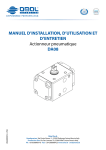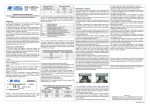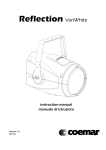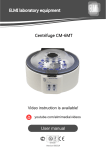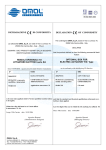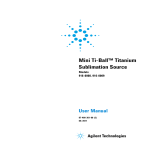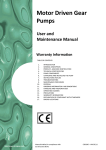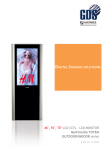Download USER`S INSTALLATION AND MAINTENANCE MANUAL
Transcript
- ENG USER’S INSTALLATION AND MAINTENANCE MANUAL Steel ball valves Omal S.p.A. Headquarters: Via Ponte Nuovo 11, 25050 Rodengo Saiano Brescia Italy Production Site: Via San Lorenzo 70, 25069 Villa Carcina Brescia Italy Ph: +39 0308900145 Fax: +39 0308900423 www.omal.it - [email protected] USER’S INSTALLATION AND MAINTENANCE MANUAL Steel ball valves USER’S INSTALLATION AND MAINTENANCE MANUAL Steel ball valves 1) FOREWORD Pag. 1 2) OPERATION CONDITIONS Pag. 2 3) RISK ASSESSMENT Pag. 2 LIMITS OF USE 4) TRASPORTATION AND STORAGE/WEARHOUSING Pag. 3 TRASPORTATION STORAGE 5) INSTALLATION INSTRUCTIONS Pag. 3 HANDLING ASSEMBLY COMMISSIONING SHUTDOWN VALVE REMOVAL INSPECTION SEALING IN CASE OF EMERGENCY 6) MAINTENANCE Pag. 6 7) DISPOSAL OF THE PRODUCTS AT THE END OF THEIR LIFE CYCLE Pag. 6 8) SPARE PARTS Pag. 6 9) TROUBLESHOOTING Pag. 7 10) STATEMENT OF CONFORMITY Pag. 7 1. FOREWORD The present User’s Installation and Maintenance Manual has been edited in conformity with: -97/23/CE Directive “Pressure equipment” PED -2006/42/EC Directive “Machinery” -94/9/CE Directive “Equipment and protection systems designated to be used in potentially explosive atmospheres” (ATEX) The following standards/technical specifications also apply: - IEC 61508:2010-1/7 Functional safety of electrical/electronic/programmable electronic safety-related systems. Part 1:7 OMAL S.p.A. reserves the right to change, at any time, the features and data of its own products, to better improve the quality and the duration of said products. Revision date: 02/2014 The present, cancels and replaces any previous documents. 1 Omal S.p.A. Headquarters: Via Ponte Nuovo 11, 25050 Rodengo Saiano Brescia Italy Production Site: Via San Lorenzo 70, 25069 Villa Carcina Brescia Italy Ph: +39 0308900145 Fax: +39 0308900423 www.omal.it - [email protected] USER’S INSTALLATION AND MAINTENANCE MANUAL Steel ball valves -UNI CEN/TS 764-6:2005 Pressure equipment Part 6: Operating instructions structure and contents. It’s up to the reader to find his own product, and the correct operating conditions, possibly referring to the attached drawings. Below you will find the safety instructions, the minimum information for storage / warehousing, the installation, the commissioning, the maintenance and the instructions for disposal of products at the end of their life cycle. The Omal valves are CE marked in accordance with the Directives 97/23/CE (PED) and/or 94/9/CE (ATEX). The company disclaims any liability for damage caused by improper use, even if partial, respect to the information contained in this manual. 2. OPERATION CONDITIONS Every type of valve is described in an accurate way through one or more dedicated drawings. The type of valve, the maximum permitted operating conditions, as well as other important information, are shown in a label or are engraved directly on the valve itself; the appropriate certification (PED, ATEX, API, etc.) is also indicated. The category identification and compliance assessment have been done in conformity with Annex II, table 6 of the PED Directive; this way the most restrictive conditions have been considered. 3. RISK ASSESSMENT Limits of use The Omal valves are suitable for both indoor and outdoor uses. The technical characteristics of the valves, such as the type, the size, the maximum operating pressure, the maximum and minimum operating temperature, the flange connection, the serial number, are all indicated body and/or on the label. Do not use the valves beyond the operating conditions (both environmental and performance) or beyond the features stated by manufacturer. The external surface of the valves in carbon steel is not provided with a protective coating but with simple burnishing treatment. It is the end user’s responsibility to protect the external surface of the valve against corrosion and wear with a coating that is suitable for the installation environment. The stainless steel valves can be used in environmental conditions such as corrosive atmospheres or with low temperature. In the case of special installations (ex. Off shore applications), it is for the end user to protect the outer surface of the valve from corrosion and wear with a suitable coating. The valves with the ATEX configuration, can be installed in areas with potentially explosive atmospheres (EX II 22 GD c TX X). It is recommended to protect the valve, with appropriate devices, from overpressure generated by the use of volatile gases or from possible pressure increase due to overheating (ex. fire). The valves are designed for an on / off type of use and are not safety valves. They must also not be used in an underwater environment and with an external pressure greater than the atmospheric one. Always follow the operating conditions printed on the label or engraved on the valve itself: do not, in any case, exceed such limits as exceeding even one of these limits could lead to dangerous situations and impair the functionality of the valve. The following are the main hazardous conditions that have not been eliminated • Weather Elements (wind, snow, ice, etc.); • Vibrations (resulting from the plant or from the fluid passage); • Water hammer (in case of rapid closure of the valve); • Corrosion (aggressive atmosphere or valve not suitably protected); • Stray current; • Shock waves; Omal S.p.A. Headquarters: Via Ponte Nuovo 11, 25050 Rodengo Saiano Brescia Italy Production Site: Via San Lorenzo 70, 25069 Villa Carcina Brescia Italy Ph: +39 0308900145 Fax: +39 0308900423 www.omal.it - [email protected] 2 USER’S INSTALLATION AND MAINTENANCE MANUAL Steel ball valves • Uncontrolled chemical reactions. 4. TRASPORTATION AND STORAGE/WEARHOUSING Transportation The OMAL valves are properly packaged for an adequate protection during handling and dispatch. Since it cannot be excluded that the product could accidentally get damaged during transportation, it is recommended to carefully check the same upon receipt, before putting it in stock. Verify, therefore, that the packaging, upon reception, is intact, free of damage due to bumps or falls that may have occurred during transportation. Also check that the product that has been received corresponds exactly to what had been requested. The handling of packages on pallets wrapped in shrink wrap barrier, does not require special care; if the package is damaged check if the product has been damaged also, or if there’s anything missing. All handling operations must be carried out with suitable means and by qualified personnel. Storage Choose clean sites for storage, not excessively humid and with temperatures between –10 and +60°C. If the products are to be stored for long periods of time, it is best not to remove them from their protective packaging. Keep the valves in the package during storage. If the valves are not packaged, then they must be protected by applying plastic caps to the ends, which are usually supplied with the product, in order to avoid liquid or other from penetrating during storage and thus damaging the ball or the seals. Should it appear appropriate to apply products for the preservation and protection of the valve, make sure it is dry also on the inside. If the valves are to be stored for long periods of time, then they should be inspected periodically: check in particular the possible presence of rust, oxidation, paint nicks or even partial unscrewing of the closures. It is also recommended to perform a complete dry cycle of opening and closing of the valve. The seals, in polymer, are subject to aging, losing their characteristics: for this reason, after storage periods of more than two years, it is recommended to check the functionality and the seals before mounting the valve in the line. In the case of flanged valves stored outside, the machined surfaces must be protected with anti-rust varnish and closed with waterproof wood seals, complete with gaskets. 5. INSTALLATION INSTRUCTIONS The design of the valve takes into account the loads arising from the line (axial forces, bending moments, etc.), as required by the reference standards. Before the assembly of the valve in line, check the conditions, making sure of the integrity of all the parts. Also, check the information on the label or engraved on the valve, to ensure the correct operating conditions. Replace any caps on the ends to preserve the valve interior during the handling. If the valve is supplied with a bare stem, carefully follow the installation instructions provided together with the actuator and possible reducer. Such operations must be carried out by an experienced and qualified staff. The use of an actuator allows to open and close the valve connected to it, without manual operations by means of levers or hand-wheels, but through an electro-pneumatic remote command. The normal sizing of the actuators requires to consider an appropriate safety margin in order to guarantee the valve maneuvering. The plant design, physical or chemical characteristics of the fluids, special environmental conditions, may require an increase of the safety factor to be applied to the sizing. Prior to installation verify that valve and the actuator comply with the above described safety standards. Furthermore, utmost cleanliness is required when connecting the air supply to the actuator. All parts of the plant, reductions, joints, plates, brackets and equipment must be thoroughly cleaned. Before mounting the actuator on the valve be sure that both elements are correctly oriented, depending on the rotation direction needed. 3 Omal S.p.A. Headquarters: Via Ponte Nuovo 11, 25050 Rodengo Saiano Brescia Italy Production Site: Via San Lorenzo 70, 25069 Villa Carcina Brescia Italy Ph: +39 0308900145 Fax: +39 0308900423 www.omal.it - [email protected] USER’S INSTALLATION AND MAINTENANCE MANUAL Steel ball valves Always read the specific instructions carefully before operating the actuator, in order to avoid damage to the valve, the plant and the actuator itself. Handling The valves must be handled by experts and with adequate protection devices. The actuated valves must not be handled through the actuator. For valves weighing less than 25 kg, handling can also be done through manual means. For valves with total weight above 25 kg, the unit must be handled with suitable means (such as slots, eyebolts, etc.). If there aren’t any holes or eyebolts you can use the ends, appropriately harnessed, to move the valve. Be careful not to damage the machined surfaces with chains or hooks. Always use approved lifting equipment (hooks, straps, etc.) to bear the weight of the valve and actuator together; this weight is indicated in the shipping documents. However, avoid handling suspended loads above people, or in places where a possible fall can cause damage. Assembly To prevent damage and protect the valve interior, remove the caps only upon installation. Verify that the inside of the pipe is clean and free of any object or particles that can damage the ball or other parts of the valve. If not otherwise indicated, the valves are bi-directional and can be mounted on either side. In the event that the valve is unidirectional, an arrow ill show clearly the flow direction. In this case, make sure that the flow direction coincides with the direction of the arrow. Flanged valves It is totally the installer’s responsibility to couple the valve in the line. Place the valve with the ball fully open or fully closed, so as to avoid damage to the sealing surface of the seats and of the ball itself. Verify that the surfaces of the flanges of the valve and the piping are parallel and properly coupled with the seals. If during assembly, the exterior painting should get damaged, it is necessary to restore the integrity of the coating. Take special care during assembly, to not let foreign objects of any type or size in line, for this could jeopardize the correct and safe operation of the valve and the system itself. Valves with welded ends The connection through permanent joint between the valve and the line is of the person installing the valve in the plant sole responsibility. During welding hold the valve in the open position to prevent damage due to thermal expansion, especially the bonding of seats. Commissioning The following operations are required before start-up: • Inspection and testing of the valve and the line; • Flushing • Hydraulic test of the line. Inspection and testing of the valve and the line Once the valve is connected in line, before proceeding to the pressurization of the same, it is necessary to: • Check (if any) the presence of caps, nipples, drain valves and their correct tightening; • Check the tightness of bolts and/or screws between the body/flange and body and lids; • Read the instructions and any restrictions regarding the use of the actuator (if any). Flushing The flushing phase is very delicate: if not done properly it may affect the functionality of the valve itself. The cavities of the valve, in fact, can accommodate foreign objects and thus influence its proper functioning. In the case in which fluids that carry abrasive materials are being used, these can be very dangerous, because they can damage the soft seals and the sealing surfaces. The valves with soft seal seats, Omal S.p.A. Headquarters: Via Ponte Nuovo 11, 25050 Rodengo Saiano Brescia Italy Production Site: Via San Lorenzo 70, 25069 Villa Carcina Brescia Italy Ph: +39 0308900145 Fax: +39 0308900423 www.omal.it - [email protected] 4 USER’S INSTALLATION AND MAINTENANCE MANUAL Steel ball valves in fact, are designed to intercept clean fluids, free of solid and abrasive particles. It can be done after completing the installation, cleaning the system from inert gases, vapors or liquids (always checking the compatibility of the fluid that is being used, with the valve), to remove any residue, grease or oil, or foreign objects. Always use fluids that are compatible with the material of the valve and of the seals; especially if the following materials are being used, consider as follows: • Amine based corrosion inhibitors may damage the O-ring which is fluorocarbon based; • The use of methanol may damage some types of O-rings; • Water, especially without inhibitors, may cause the corrosion of carbon steel parts; • Fluids containing fluorine and its derivatives can trigger the corrosion of stainless steel parts. Hydraulic test of the line The hydraulic test of the line should be carried out at a pressure that does not exceed 1.5 times the rating pressure of the valve, indicated on the nameplate or engraved on the body of the valve itself. The test shall be performed with the ball in a half open position so to avoid damaging the seats. If the test is performed on valves that are sealed with polymeric material, keep the ball in a semi open position, during the testing time only and no longer than a few hours. Should it be necessary to test the valve in the closed position, the maximum pressure should not exceed 1.1 times the rating pressure. Once the test is over, depressurize the line and, if possible, vent and discharge the valve. Once that the previous operations have been carried out, the valve is now ready for operation; if the valve is manually operated (by lever, wheel or reducer), make at least one complete opening and closing maneuver, so to verify its proper functioning. If the valve is actuated, read the instructions carefully, check the pneumatic or electric diagrams and then proceed with a complete opening and closing cycle, so to verify its proper functioning. In order to avoid a functional failure of the valves is recommended to perform a partial maneuver at least once a year. Shutdown If problems occur on the valve, if possible, close the valves upstream and downstream and shut the pressure to the line. Then perform a complete inspection of the valve so to identify the fault. After a system shutdown, before maneuvering the valve, empty it out (if possible) and drain it as well. Valve removal Before the valve can be removed from the line, it is necessary to: • always make sure that the pipeline is not pressurized; • actuate the valve by performing an opening/closing cycle so to eliminate any residual pressure trapped inside the body. Never and in any case use vent plugs or drains to drain out the pressure from the valve body; • perform accurate flushing cycles with inert fluids or specific corrosion inhibitors, if the valve intercepts substances that are dangerous, corrosive, explosive etc.. and ensure safety measures; • use suitable personal protective equipment PPE before opening the valve-pipe connections. After removing the valve from the line, thoroughly clean it and protect the ends by covering them with caps. Inspection The operating conditions can be very different it is therefore, up to the user to establish an adequate inspection interval that is based on the system, the intercepted fluid, operating conditions, etc. Sealing in case of emergency Some valves are equipped with injectors in correspondence with the stem and the seals in order to seal the valve in case needed (usually to stop a leak). Before proceeding with the sealing operation, make sure the sealer is compatible with the materials of the valve and the intercepted fluid, so to avoid dangerous chemical reactions that could cause harm to people, the environment and to the system. 5 Omal S.p.A. Headquarters: Via Ponte Nuovo 11, 25050 Rodengo Saiano Brescia Italy Production Site: Via San Lorenzo 70, 25069 Villa Carcina Brescia Italy Ph: +39 0308900145 Fax: +39 0308900423 www.omal.it - [email protected] USER’S INSTALLATION AND MAINTENANCE MANUAL Steel ball valves The flushing fluids and sealers can be pumped in by a manual or pneumatic pump, checking that the nominal pressure of the pump and accessories is higher than the rating pressure of the valve. 6. MAINTENANCE The efficiency of the product is the result of a good and careful maintenance; check the system efficiency status at least once a year, providing for the immediate replacement of parts that are subject to wear, in case leaks are found, both in the ducts and on the outside of the valves. Normally, for medium duty applications, the replacement time of parts subject to wear for the various types of valves is summarized in the table below. Maintenance operations must be performed by qualified personnel. Steel ball valve ≤ PN 100 Steel ball valve > PN 100 DN 15-25 30000 15000 DN 32-50 25000 10000 DN 65-100 20000 5000 DN 100-200 15000 5000 7. DISPOSAL OF PRODUCTS AT THE END OF THEIR LIFE CYCLE Once that the valve has reached the end of its operating life, it can be removed from the system by following the procedures that are suitable to the type of valve and to the operating conditions. If the valve intercepts toxic, corrosive and/or hazardous substances, it must first be cleared by an appropriate flushing cycle and the waste is to be disposed of according to the applicable regulations. Once removed from the system, protect the ends and all the possible openings (valve drains, nipples, etc.) through an appropriate sealing system, in order to prevent the dispersion and the contact by any pollutants or hazardous materials, left inside the valve. In the case of a fluid leakage from inside the valve occurs, it is required to act promptly, decontaminate and secure the contaminated environment, as required by the relevant laws and regulations. The personnel in charge of the product disposal/recovery, must be qualified and equipped with appropriate personal protective equipment (PPE), according to the type of fluid intercepted (polluting, corrosive, etc.). Once disassembled and secured, bring the valve to a site that is designated as the storage site and that complies with the requirements of the European national, regional and municipal environmental and safety standards. The management of waste generated during the installation, extraordinary maintenance or due to the product disposal, is governed by the rules in force in the country where the product is installed, in any case, the following are the general guidelines: - The metal components (aluminum/steel) can be restored as raw material; - Seals/sealing elements (PTFE, PEEK, NBR, EPDM, FKM ...), as contaminated by fluids from other materials and lubrication, must be disposed of; - The packaging materials that come with the product, should be transferred to the differentiated collection system available in the country. 8. SPARE PARTS Use only original spare parts, for maintenance; always mention, when ordering the spare parts, the part number and date of manufacture stamped on the valve, to be sure to receive spare parts that are compatible with the product in the most recent version possible. For detailed information on the mounting and dismounting, refer to the specific instructions for each type of valve. Omal S.p.A. Headquarters: Via Ponte Nuovo 11, 25050 Rodengo Saiano Brescia Italy Production Site: Via San Lorenzo 70, 25069 Villa Carcina Brescia Italy Ph: +39 0308900145 Fax: +39 0308900423 www.omal.it - [email protected] 6 USER’S INSTALLATION AND MAINTENANCE MANUAL Steel ball valves 9. TROUBLESHOOTING Listed below are a number of main failures with possible causes and possible solutions. PROBLEM POSSIBLE CAUSES Ball not completely closed Worn seals / ball Valve leak Chemical incompatibility with valve structure materials O-ring seal damaged Upper or lower stem seals leak Body damaged Stem damaged Drive system failure Ball /stem possible binding Valve blocked Stem broken Actuator valve connection broken Increased operating/movement Ball /stem possible binding Possible partial binding of actuator time The actuator fails to perform the maneuver Supply air not enough to produce the required torque Mechanical stop (if present) is not Insufficient rotation angle properly adjusted Ball /stem possible binding Wrong fixing between actuator outlet hole and valve stem SOLUTION Check the control mechanism Replace worn components Contact Omal Replace worn components Replace worn components Replace worn components Contact Omal Contact Omal Contact Omal Contact Omal Contact Omal Contact Omal Verify actuator dimensions Increase supply air Adjust the stops to increase the stroke Contact Omal Check fixing and size of the adapter between the valve and the actuator 10. STATEMENT OF CONFORMITY The OMAL ball valves have been designed, manufactured and tested to meet the requirements of the following European standards and are marked, where provided, with the relative CE conformity marking: 97/23/CE Directive “Pressure equipment” PED 2006/42/EC Directive “Machinery” 94/9/EC Directive “Equipment and protective systems intended for use in potentially explosive atmospheres” (ATEX) Regulation (EC) No 1907/2006 and successive Concerning the Registration, Evaluation, Authorization and Restriction of Chemicals (REACH) 7 Omal S.p.A. Headquarters: Via Ponte Nuovo 11, 25050 Rodengo Saiano Brescia Italy Production Site: Via San Lorenzo 70, 25069 Villa Carcina Brescia Italy Ph: +39 0308900145 Fax: +39 0308900423 www.omal.it - [email protected]








